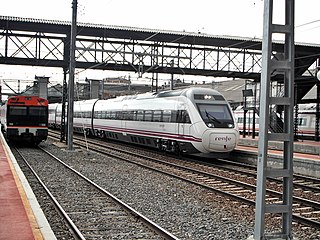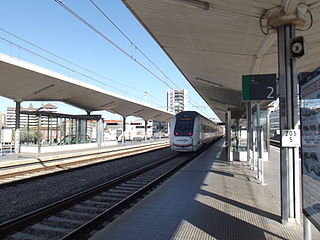Transport in Spain is characterised by an extensive network of roads, railways, rapid transit, air routes, and ports. Its geographic location makes it an important link between Europe, Africa, and the New World. Major forms of transit generally radiate from the capital, Madrid, located in the centre of the country, to link with the capitals of the autonomous communities.

Rail transport in Catalonia operates on three rail gauges and services are operated by a variety of public operators:

Alvia is a high-speed train in Spain used by Renfe Operadora for long-distance service with a top speed of 250 km/h. The trains have the ability to use both Iberian gauge and standard gauge, which allows them to travel on the recently constructed high-speed lines for part of the journey before switching to the ″classic″ Iberian gauge network to complete it. Trains that run exclusively on high-speed tracks are branded AVE or Avant.

The RENFE Class 130 or S-130 is a high-speed dual-gauge, dual-voltage trainset consisting of 11 Talgo VII tilting coaches and two power cars, used on Alvia services. The class have been nicknamed patitos (ducklings), due to the shape of the train nose.

The RENFE Class 120 are high-speed electric multiple units used on Alvia services in Spain.

The Madrid–León high-speed rail line was inaugurated on 29 September 2015. The line is built to standard gauge and gauge changers are provided at strategic points to allow interchange with older Spanish railways which were built to Iberian gauge.
The 2009–10 Spanish football season is Xerez's first season ever in Liga BBVA.
The 2010–11 Copa del Rey was the 109th staging of the Copa del Rey. The competition began on 21 August 2010 and ended on 20 April 2011 with the final, held at the Estadio Mestalla in Valencia, in which Real Madrid lifted the trophy for the eighteenth time in their history with a 1–0 victory over Barcelona in extra time. Sevilla were the defending champions, but they were defeated by Real Madrid in the Semi-finals.
The 2011–12 Copa del Rey was the 110th staging of the Copa del Rey. The competition began on 31 August 2011 and ended on 25 May 2012 with the final, which was held at the Vicente Calderón Stadium in Madrid. Entering the competition, the winners were assured of a place in the group stage of the 2012–13 UEFA Europa League. Real Madrid were the defending champions, but were eliminated by Barcelona in the quarter-finals, who went on to win the title.

Gare de Cerbère is the railway station serving the border town Cerbère, Pyrénées-Orientales department, southern France. It is connected to the Portbou railway station in Spain.
The 2014–15 Copa del Rey was the 113th staging of the Copa del Rey. The winners assure a place for the group stage of the 2015–16 UEFA Europa League.
The 2015–16 Copa del Rey was the 114th staging of the Copa del Rey. Going into the tournament, the winners were assured a place for the 2016–17 UEFA Europa League Group stage. However, since the two finalists, Barcelona and Sevilla, both qualified for the 2016–17 UEFA Champions League, respectively by winning the 2015–16 La Liga title and the 2015–16 Europa League, the cup winner's place in the 2016–17 Europa League group stage instead passed to the fifth-place team in La Liga, Athletic Bilbao.
The 2000 Copa del Rey Juvenil was the 50th staging of the tournament. The competition began on 14 May 2000 and ended with the final on 25 June 2000.
The 2008–09 Sporting de Gijón season was the first season that the club played in La Liga, the highest tier of football in Spain, eleven years after its last time.
The 2016–17 season is the 85th season in Málaga CF's history and it's 36th in La Liga.
The 1989–90 Sporting de Gijón season was the 29th season of the club in La Liga, the 15th consecutive after its last promotion.
The 2018–19 Copa del Rey is the 117th staging of the Copa del Rey. The winners will be assured a place for the 2019–20 UEFA Europa League group stage.
The 1983–84 Sporting de Gijón season was the 23rd season of the club in La Liga, the 9th consecutive after its last promotion.











